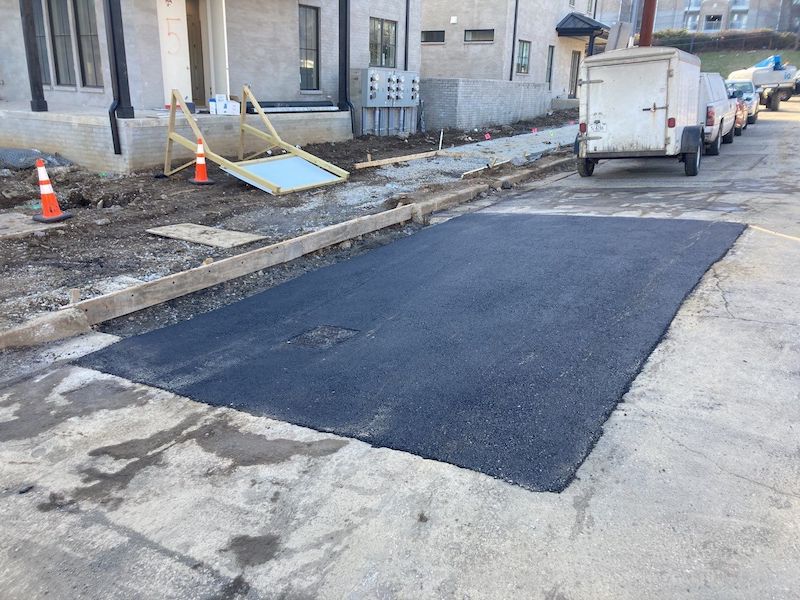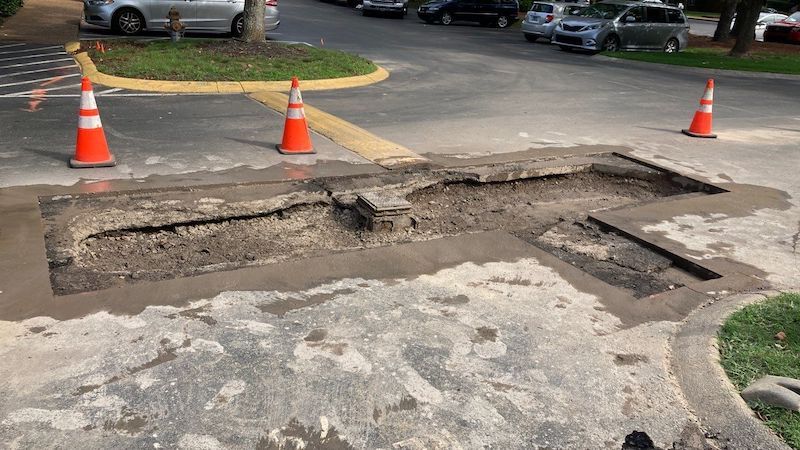Nashville TN Asphalt Patching 101 | The Importance of Proper Compaction
Table of Contents
ToggleWe all know how important smooth, solid pavement is for creating a safe environment for traffic – and how much impact potholes can have on driving conditions. But did you know proper compaction is just as crucial for ensuring asphalt retains its durability? Gaddes Strategic LLC, with years of experience in construction and asphalt compaction, knows the importance of proper techniques for ensuring pavement performance.
Asphalt patching can be daunting, but this article is here to ensure you’re given Nashville asphalt patching 101 the importance of proper compaction to be informed about the significance of appropriate compaction and the best practices to get the job done right, using HMA (hot mix asphalt) and the suitable machines for compaction. Read on to take your asphalt paving knowledge to the next level.
Quick Review
Proper asphalt compaction, using machines like paver and rollers, is essential for achieving a solid and durable patch. Compacting correctly helps prevent cracking, potholes, raveling, and other problems caused by poor compaction. Moreover, it ensures optimal pavement performance and can withstand significant temperature changes.

The Importance of Proper Compaction for Asphalt Patching
Asphalt patching projects require proper compaction for several reasons. Compaction prevents air from infiltrating beneath the surface, which can cause deterioration in the subgrade and diminish the pavement patch’s life. In addition, it increases the durability of the asphalt and reduces the potential for developing stress cracks. Compact patches also help lock each layer together, especially in areas exposed to freeze and thaw cycles. Uncompacted patches are more prone to displacement as weather or vehicular traffic changes.
Compacting asphalt also further increases pavement strength to withstand greater loads over time. It helps create a smooth surface by reducing the amount of loose material. Proper compaction, asphalt can better hold aggregate blading, improving its appearance. Good compaction results in longevity, stability, and resistance to climate changes and vehicle loading.
The importance of compaction cannot be overstated; however, there have been anecdotal instances that patches perform adequately when not compacted properly, depending on local prevailing climate conditions and site-specific variables.
Proper compaction is essential for achieving quality patch results, and asphalt patching can result in satisfactory results. Moving forward, it is necessary to understand precisely how poor compression of an asphalt patch can damage a surface, including consequences related to climate exposure, structural integrity, aesthetics, durability, and safety factors.
How Does Poor Compaction of an Asphalt Patch Damage the Surface?
While proper compaction of an asphalt patch is crucial to its longevity, poor compaction can lead to many problems. The asphalt patch surface may become rutted without proper compaction and lose its uniformity. This can lead to water seeping into the patch, causing slight shifting, which, over time, will cause the pavement to crack and erode. Poor compaction can also lead to loose aggregate being thrown up from the pavement’s surface due to vehicular traffic. Loose aggregate creates a more rough and bumpy ride, further damaging the pavement’s surface and deteriorating lifespan.
While it is vital for an asphalt patch to be adequately compacted to remain functional and safe, an over-compacted patch can be just as detrimental. Excess compaction can damage asphalt binder oils, causing them to harden too much or crack too quickly. Additionally, if done incorrectly, compaction can cause segregation or displacement of aggregates, which can lead to weakened areas at the surface and eventually contribute to larger cracks or potholes in the road.
When repairing a damaged asphalt pavement surface with an asphalt patch, proper compaction techniques must be applied so that neither inadequate nor excess compaction occurs. There need to be more adequate compaction techniques to ensure the integrity of any new or existing pavement surface is maintained. Therefore, understanding the methods used in proper compaction is essential for ensuring optimal results and longevity for paved surfaces. The following section will explore these techniques by examining compaction efficiency factors.
Factors that Impact Compaction Efficiency
It is essential to consider the factors that impact compaction efficiency when patching asphalt. Temperature, which ranges from cool to hot, affects moisture content and density and should be considered before starting a repair project. The experience of the construction team and the correct usage of machines like paver and rollers also significantly contribute to proper compaction and pavement performance. In addition, equipment selection and the size and shape of the material also play a significant role in achieving optimal compression. This is especially true when considering the pavement maintenance process, where expertise in various aspects, including moisture damage prevention, vibration control, and proper placement of mixes and binders, is crucial.
When patching asphalt with cold material, it is difficult to achieve desired densification due to the limited mobility of the material’s constituent particles. On the other hand, using too much heat to warm up the material can cause vaporizing of the volatile binder component and the overall loss of strength of the mix. Finding an optimal balance is key for efficient compaction, paving process execution, and achieving desired results in terms of permeability and resistance to moisture damage.
When selecting equipment, it is essential to use one that not only effectively compacts asphalt patches but also avoids leaving marks on the surface or breaking down too quickly due to high traffic. Furthermore, the material’s size and shape also influence compaction since rectangular aggregate particles tend to reduce interlock between particle surfaces, thus hampering proper densification.
As such, paying attention to particle shape and size is essential.
Thus, attention must be paid to all these factors for successful asphalt patching as they all contribute significantly to achieving proper compaction. With appropriate management of these variables and correct layer depth selection, successful installation and longer-lasting repairs may be achieved, resulting in more cost-efficient projects in the long run. Now that we have discussed how different factors influence compaction efficiency, our next step is to explore what constitutes an appropriate asphalt mixture used in patching and the associated layer depths required for each type.

The Asphalt Mixture and Layer Depth
The asphalt mixture used for patching has a critical role in compaction efficiency. For proper compaction to be achieved, the correct mix design and content of mineral aggregate and asphalt binder must be carefully selected. In addition, the layer depth when applying the asphalt is significant. Experts agree that asphalt should not be placed in layers over 4 inches; otherwise, compaction rates become harder to achieve.
However, some may argue that compacting layers of up to 8 inches with proper techniques are possible. While there may be evidence suggesting this, the reality is that it requires specialized equipment and more effort and time to reach acceptable compaction results—both of which can result in elevated costs. Therefore, most experts suggest keeping layer depths at four inches or less whenever possible to ensure proper compaction without causing too much disruption or expense.
Understanding how an asphalt mixture impacts compaction efficiency and ensuring layer depths remain within the recommended range will help pave the way toward achieving optimal road quality. Next, look at different methods utilized to compress asphalt to ensure successful compaction rates are obtained.
Different Methods Used to Compress Asphalt
The asphalt mixture and layer depth are essential when patching, but proper compaction of the asphalt material is also necessary for a successful patching job. Compaction is simply the process of compacting or consolidating the asphalt material, which removes air voids and allows for better cohesion of the particles. Different methods are used to compress asphalt, so it’s essential to understand what works best given your specific environment and objectives.
Manual labor may be a suitable option for smaller patches, using hand-operated vibratory plates and tampers. While this method may provide satisfactory results for small areas, large-scale patching jobs require mechanical compaction. Mechanical compaction includes rolling techniques, typically involving vibratory rollers and pneumatic tire methods, which use heavy rubber-tired rollers to produce high-compaction forces. There are advantages and disadvantages to each method. At the same time, vibratory rollers provide faster coverage due to their smooth continuous rolling motion, and pneumatic tire rollers have been proven to give greater densities and longer-lasting patches.
Regardless of your chosen method, achieving adequate compaction levels is critical for quality assurance and should be tested during the project.
To ensure specifications are met, consider using hand-held or mounted testing devices such as analyzers and nuclear density gauges to measure moisture content and density levels in minutes easily.
Asphalt patching requires a combination of specialized materials with specific proportions and application techniques, like proper compaction, which can make or break the success of your patching job. In the next section, we will focus on how different types of tools more commonly used to achieve these desired compaction levels affect the result of your work – pneumatic tools and tamping vs. rolling. These techniques are widely employed by businesses providing asphalt patching services to the construction industry. Factors like mix temperature, air temperature, and thickness of layers play a critical role in preventing rutting and ensuring longevity.
Pneumatic Tools and Tamping vs. Rolling
Once an asphalt patch is installed, it must be appropriately compacted to ensure a long-lasting result. Two of the most common methods contractors use in the asphalt patching service to compress an asphalt patch are pneumatic tools and tamping versus rolling. These businesses offer their services to clients within the construction industry, ensuring that they provide the best compaction process suited for individual project requirements.
Pneumatic tools, such as tampers and plate compactors, use air pressure to press down on the newly laid asphalt patch, which causes the entire surface area of the patch to be evenly compacted. Tampers tend to take less effort and time than plate compactors; however, they have a greater tendency for uneven compacting due to the nature of their design. Plate compactors provide more uniform compaction but require more manual labor due to the weight of the equipment itself.
In comparison, rolling uses a large cylinder-like device that mechanically presses down on the asphalt patch using heavy weights to smooth it out and supply even compaction. This method is commonly seen with commercial jobs as it is usually more cost-effective in larger-scale projects due to its high-efficiency level and quality-produced results. The downside is that it requires a specialized machine a skilled contractor operates to work correctly.
Comparing these two methods highlights their benefits, but what ultimately matters is that whichever way is used, proper compaction should be implemented for the patching job to be completed successfully. Understanding this concept will help builders create a strong base by providing a dense surface free from air pockets and other imperfections, rendering a patch useless. Understanding the importance of having quality compaction when patching can make all the difference between a successful job and an unsuccessful one.
The Importance of a Quality Compaction for Patching
Compaction is an essential step for successful asphalt patching. The patch can be unstable and crack under traffic or weather conditions without proper compaction, resulting in premature repair. Therefore, it is vital for a business providing asphalt patching services to determine the best way to ensure quality compaction. Two popular methods contractors use are pneumatic tools and tamping vs. rolling.
Pneumatic tools and tamping are generally thought of as more labor-intensive than rolling, but they also provide better results in some cases. Pneumatic tools, such as tampers and plate compactors, vibrate and move under compressive force to consolidate material around the edges of the patch area, eliminating voids and helping to prevent water infiltration. This method often results in higher compaction densities than rolling alone. It ensures that smaller, tighter spaces between gravel or aggregate particles increase the patch’s durability and strength over time. The downside of this method is that it requires extra labor since someone must manually operate the machine during the entire process.
On the other hand, rolling is primarily done with a single truck with a drum that runs up and down a given section of road multiple times. This method is much faster than pneumatic tools but only provides proper compaction throughout some parts of the patch area due to its limited range of motion. Although this approach may seem attractive due to its speed, rollers only sometimes guarantee full compaction when compared to pneumatic tools and may require additional passes in order to achieve adequate density levels in certain areas. Therefore, if speed is a significant factor in your decision-making process of selecting a contractor, then you should consider how many passes will be needed for compaction versus how long pneumatic tool operation would take.
Ultimately, regardless of which technique is chosen, certain aspects of asphalt patching must remain consistent among them all, such as base preparation before patching and proper drainage after installation; however, what is most important of all is achieving durable compaction that ultimately could make or break the success of your asphalt patching project.
Answers to Common Questions with Explanations
What is the best compaction equipment for asphalt patching?
The best compaction equipment for asphalt patching depends mainly on the size, shape, and composition of the asphalt being patched. Common compaction equipment used in asphalt patching includes steel-wheeled and rubber-tired rollers, which deliver excellent results when used correctly. However, a hand tamper or plate compactor may be preferable for more minor potholes or crack repairs in thinner asphalt layers due to their lighter weight and ability to reach confined areas. Cost and job complexity should be considered when choosing the best compaction equipment for asphalt patching.
How do you determine if proper compaction has been achieved for asphalt patching?
Determining if proper compaction has been achieved for asphalt patching requires measuring and analyzing the compression of the asphalt material after installation. There are several key factors to look for to measure adequate compaction, such as density level, surface quality, and evenness. To measure density level, a nuclear densitometer can measure the “effective” density of the material before and after compaction; this will help indicate whether or not adequate compression has occurred. The surface quality of an asphalt layer depends heavily on the compacting procedures that have been followed, so upon observation. It should be free of visible flaws (spider webs, humps) that may have arisen due to improper compaction. The evenness of the material is also a great indicator of competence; it should have no noticeable dips or bumps when walking through it with your feet flat on the surface.
By examining all these measures and conducting proper testing, you can determine if proper compaction has been achieved for an asphalt patch. It is essential to ensure that proper compaction has been carried out on an asphalt patch to achieve its long-term performance and maintain a safe driving surface.
What factors should be considered when choosing the right asphalt patching compaction method?
When choosing the right asphalt patching compaction method, it’s important to consider the type and condition of the existing asphalt in the area that needs to be patched. Additionally, you should consider the size of the repair area and what kind of traffic will be used.
In general, larger areas require more compaction than minor repairs, which helps ensure a strong and even finished layer of asphalt. Additionally, heavier traffic types require more excellent compaction than light traffic areas. Understanding how much compaction is needed for a successful repair is critical; if too little compaction is used, the patch may soon fail due to poor adhesion or instability.
Finally, it’s also important to consider when and where your required compaction should occur; generally speaking, asphalt should be compacted soon after being laid to ensure its integrity before any traffic is allowed on it. For post-traffic maintenance, specialized equipment is usually required since regular compaction kitted will not be able to handle heavier traffic loads.
Ultimately, selecting the right asphalt patching compaction method requires understanding the size and importance of the repair area in question and what type of traffic will be using it. The choice of methods needs to be based on both factors for a successful patch job that lasts for years to come.
What other asphalt services require proper compaction?
Proper compaction is essential for any asphalt service, whether it be a repair or a new installation. The following are common asphalt services that require asphalt patching:

2 thoughts on “Nashville Asphalt Patching 101 | The Importance of Proper Compaction”
Pingback: Hot Asphalt Patching Services in Nashville TN
Pingback: Asphalt Patching for Businesses in Nashville
Comments are closed.